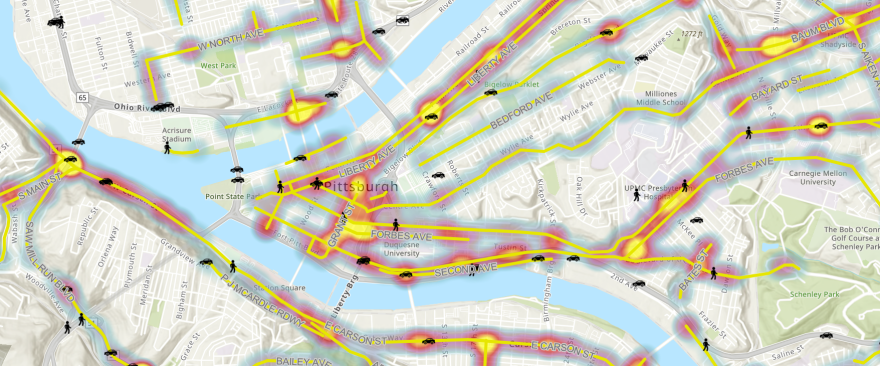Pittsburgh leaders gathered Monday to advocate for a citywide commitment to reducing traffic deaths. Mayor Ed Gainey, officials from the city’s Department of Mobility and Infrastructure and City Council members gathered outside council chambers to emphasize the benefits of traffic-calming measures, like speed bumps and traffic circles.
“When it comes to safety, we talk a lot about drugs, and we talk about guns," said Councilor Barb Warwick. "But for decades, automobile accidents in this country have reigned supreme as the number one killer of kids."
She said that while a 20% homicide increase between 2018 and 2020 grabs the headlines, fatal crashes in Pittsburgh increased during the same time by 71%.
“Those homicide rates are coming down [now], but these traffic conditions are just getting worse,” she added.
City data indicates 21 people died in a traffic-related accident in 2023 and seven were pedestrians. But the city said it’s committed to adding traffic-calming measures to slow vehicle speeds and make streets safer. Gainey’s 2024 budget doubled the city’s investment in those projects, a promise the mayor reiterated Monday.
“You said we needed this and we've invested in it,” Gainey said. “We've done what we said we would do. So now it's time for us to continue to do the work that we need to do to make this the safest city in America.”
Officials call the plan “Vision Zero" because it approaches traffic safety with the goal of zero traffic-related deaths. “Vision Zero” was first popularized in Sweden in the 1990s, and has since been adopted by cities across the globe.
Pittsburgh’s Department of Mobility and Infrastructure was initially established in 2017 on a similar premise. Two years earlier, then-Mayor Bill Peduto issued an executive order requiring the city to envision a safety plan for city streets that used “enhanced enforcement measures to achieve the vision of zero traffic fatalities.”
Kim Lucas, director of DOMI, said Monday’s message was a continuation of that work.
“We're doubling down on that commitment,” Lucas said. “This is coming with an increase in actual dollars,” and an interdepartmental group tasked with making sure projects keep moving.
According to DOMI, recent years have seen growing citywide support for speed bumps, curb extensions and protected bike lanes, with requests for the measures skyrocketing. DOMI officials said there are about 1,000 open requests for measures to slow vehicle traffic on city streets.
“And those numbers go up almost every day,” Lucas added.
In an effort to prioritize those requests, the city unveiled a map of crashes where those involved sustained injuries or died. The city’s “High Injury Network” will be prioritized for investment in traffic signal updates and traffic-calming measures.

The map highlights 122 miles of roads, out more than 1,000 miles of city roadway, where most violent crashes take place. Along those 122 miles, 86% of serious-injury-causing crashes take place as well as 76% of fatal crashes.
The map shows main roads are a frequent site of violent crashes. Hot spots include Frankstown, Baum, Center, Penn and Liberty Avenues as well as Grant Street. According to Gainey, the map is a good indicator of where to expect new traffic projects next.
“We know where these fatal crashes are happening, and we know that we can make our roads more safe,” Gainey said.
DOMI data indicates that about half of the top 10 roads with the most frequent crashes are state-owned. But according to municipal traffic engineer Michael Maloch, the city can still intervene with traffic signals and signs to slow vehicles on those roads.
The city also plans to invest $1.4 million in traffic signal upgrades, which could include broader visibility of the signals and better coordination with pedestrian crossing signals. According to Maloch, the city has upgraded 32 downtown crossing signals in the last year to include audible signals that let vision-impaired pedestrians know when it’s safe to cross.
Maloch said residents can expect to see more signal upgrades in the next two months. The city may also explore banning right-on-red turns at more intersections.
“We will be heavily increasing the amount of locations where signs are posted prohibiting turn-on-red,” Maloch said. He noted the city also posts “No Turn on Red” signs where residents request them.
In addition to financial investment, the city has also deployed a team of five engineers who will be dedicated to projects designed to improve street safety.
But Gainey stressed that street safety is not solely the responsibility of government. He argued residents have a key role to play in the effort: following the speed limit and other traffic laws.
“We can't do it unless we have the whole city together,” he said. “When you're driving your car, slow down.”





